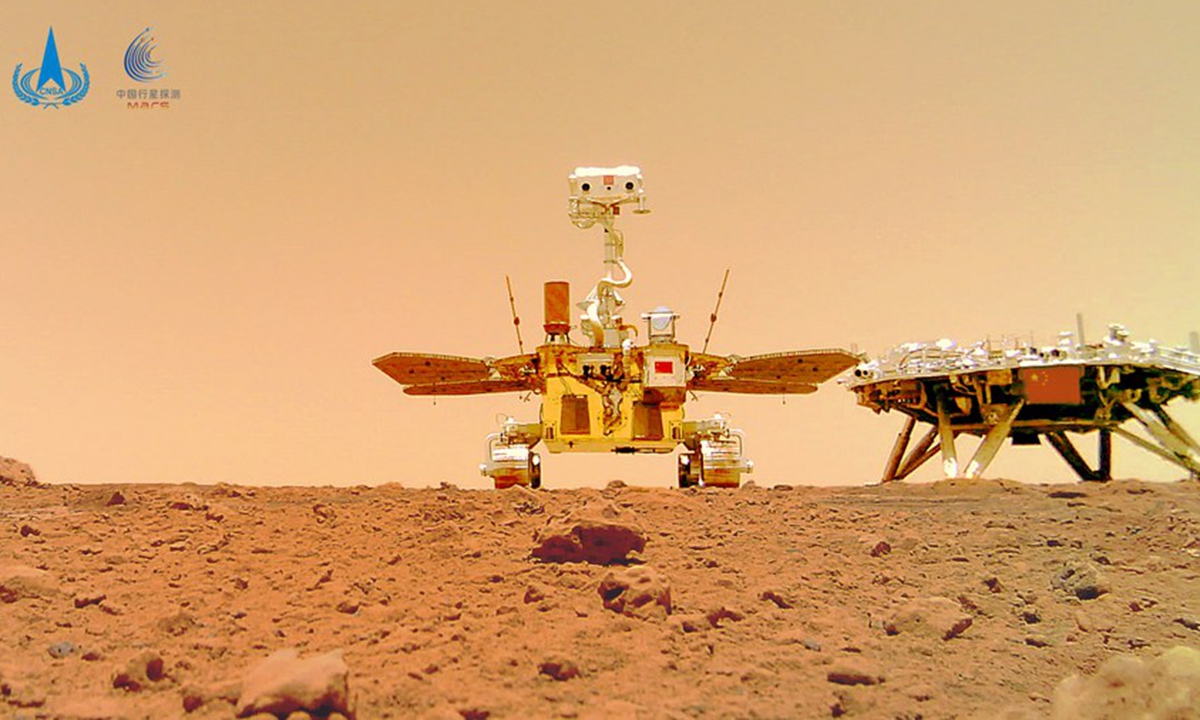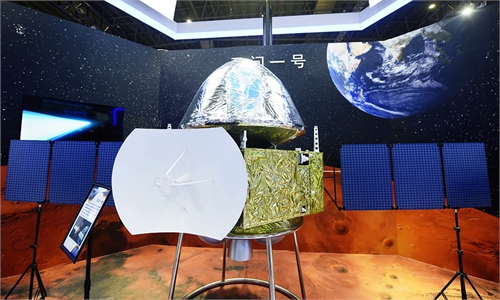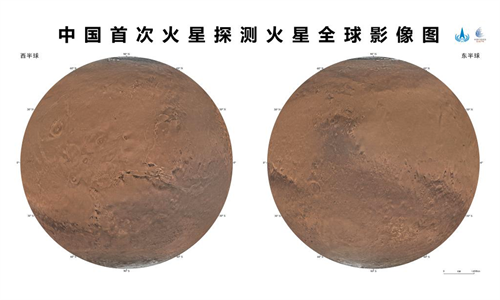
Photo released on June 11, 2021 by the China National Space Administration (CNSA) shows a selfie of China's first Mars rover Zhurong with the landing platform. Photo:CNSA
Chinese researchers have revealed for the first time evidence of liquid water on Mars formed from frost or snowfall, based on data collected from the country's Mars rover Zhurong. The discovery is of great significance for understanding the evolution of Mars' climate and the search for habitable environments, and also provides key clues for the future search for life.
The finding, published in the international academic journal Advances in Science and Research, showed that features such as crusted surfaces, cracks, granulation, polygonal ridges and band-shaped water marks were discovered on the Martian sand dunes in the landing area of the Zhurong rover.
Data analysis suggests that the dune surfaces are rich in water-containing minerals such as hydrous sulfates, protein stones and hydrous iron oxides.
"More importantly, we believe that the presence of water in the sand dunes is not formed from groundwater or carbon dioxide, but rather frost or snowfall," said Qin Xiaoguang, the paper's corresponding author and research fellow at the Chinese Academy of Sciences' Institute of Geology and Geophysics.
The presence of liquid water on Mars has long been a topic of interest, as it has significant implications for interstellar migration and understanding the evolution of the Martian climate.
The presence of liquid water could indicate a habitable environment on Mars and potentially even the existence of life, Science and Technology Daily reported on Friday.
Past researches have shown that Mars once had abundant liquid water. However, due to the disappearance of its atmosphere, the Martian climate underwent a major transformation, with extremely low air pressure and water vapor content that made it difficult for liquid water to exist stably on its surface.
However, the droplets observed on the mechanical arm of the US Phoenix Mars probe indicate that salty liquid water can occur in the high-latitude regions of Mars during summer. Additionally, numerical simulations show that climate conditions suitable for liquid water can still temporarily appear in some areas of Mars.
"However, there is still a lack of direct observational evidence for the existence of liquid water in the warmest low-latitude regions of Mars," Qin said.
In 2021, China's first Mars exploration mission Tianwen-1 successfully landed the Zhurong rover on the southern edge of Utopia Planitia, a low-latitude region on Mars. By May 2022, Zhurong had worked for over 350 Martian days and traveled about 2,000 meters, collecting a wealth of valuable scientific data.
Using Zhurong's topographic cameras, multispectral cameras and the Mars surface composition detector, researchers carried out in-depth studies of the microscopic morphological features and material composition characteristics of the sand dunes in the area.
Combined with data from the rover's weather station and meteorological data from other Mars probes, researchers determined that the water-containing features of the sand dunes in the region are related to frost or snowfall that had occurred during cooling.
"Salt-containing sand particles can promote the melting of frost or snow into salty liquid water at low temperatures. When the saltwater dries, hydrous minerals such as sulfates, protein stones, and iron oxides bind the sand particles, forming wind-sand granules and even crusts. The crusts further dry and form cracks," Qin explained.
Subsequent frost or snowfall will further form polygonal ridges and band-shaped water marks on the crusts, indicating traces of liquid water activity.
This research fills the gap in observation evidence for the existence of liquid water in low-latitude regions of Mars, revealing that the Red Planet can still exhibit humid environments in relatively warm and suitable low-latitude areas, experts said.
Global Times


